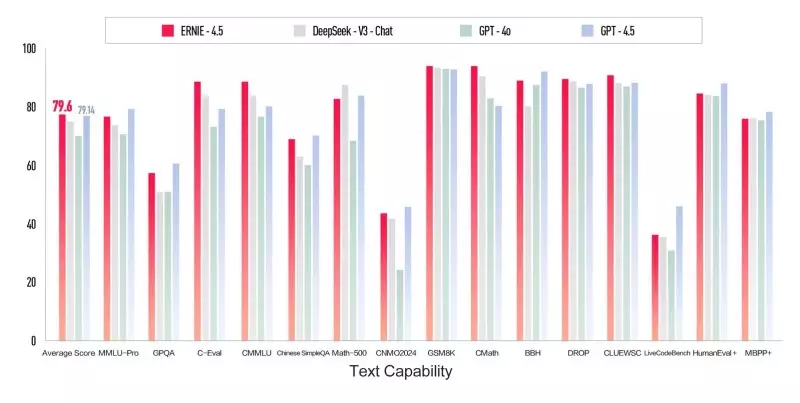Over the weekend, Baidu made waves in the artificial intelligence sector with the announcement of its latest models: ERNIE 4.5, a multimodal language model, and ERNIE X1, a reasoning model. In an industry increasingly dominated by global players like OpenAI and DeepSeek, Baidu is positioning itself as a formidable competitor. These new models reportedly excel in various benchmark tests designed to evaluate performance in areas such as knowledge and reasoning, presenting the AI landscape with a compelling alternative to established options.
What stands out most about these announcements is not just the bold claims of superiority over OpenAI’s GPT-4.5 and DeepSeek’s models, but also the staggering cost advantages Baidu emphasizes. The claim that ERNIE X1 can outperform its competitor’s reasoning models at half the cost, and ERNIE 4.5 can deliver results at a jaw-dropping 99% lower cost than GPT-4.5, is certainly eye-catching. However, such dramatic assertions demand scrutiny and a thorough examination of the models’ capabilities and limitations.
Contextual Limitations: A Double-Edged Sword
While the promise of low-cost AI solutions is enticing, both ERNIE models come with significant constraints. Notably, the small context window of 8,000 tokens for ERNIE 4.5 pales in comparison to previously established benchmarks of 128,000 tokens found in competing models. In real-world applications, a reduced context can substantially limit an AI’s effectiveness, especially in tasks requiring deep comprehension and intricate reasoning. As noted by users in various forums, this limitation could make ERNIE 4.5 more suited for straightforward tasks like customer service chats rather than complex scenarios requiring extensive context.
This raises critical questions about the actual applicability of these models in different environments. While Baidu’s initiative to make ERNIE 4.5 open source in 2025 may drive innovation in the longer term, the immediate lack of open-source availability stifles wider experimentation and collaboration within the global AI community. Companies looking to leverage AI for intricate tasks may hesitate to adopt technology that could inhibit their operational capabilities due to context constraints.
Technological Innovations and Competitive Edge
Despite these drawbacks, Baidu’s approach to maximizing performance through innovative techniques like FlashMask Dynamic Attention Masking and Self-feedback Enhanced Post-Training should not be dismissed. These advancements signal Baidu’s commitment to staying at the forefront of AI research. The model’s enhancements in hallucinatory output prevention and logical reasoning capability may provide competitive advantages worth exploring.
Moreover, ERNIE X1’s focus on advanced reasoning and tool integration positions it uniquely for enterprise applications. The ability to manage searches, document-based Q&A, and even code execution could make it a game-changer for businesses seeking automation and efficiency. As organizations worldwide look to streamline operations through AI integration, the appeal of Baidu’s offering becomes more pronounced, especially in industries where these tasks can lead to significant productivity gains.
The Pricing Strategy: An Attractive Proposition
With the pricing structure for ERNIE models heavily undercutting that of competitors, organizations evaluating AI solutions may view Baidu’s offerings as more accessible. Baidu has conveniently positioned itself with an input rate for ERNIE 4.5 at $0.55 per million tokens and ERNIE X1 at an even lower rate of $0.28, making the models particularly appealing for businesses on a budget. However, the low costs are juxtaposed with the potential for operational shortcomings due to the aforementioned limitations.
As Chief Information Officers (CIOs) and other tech leaders consider adopting these technologies, they must weigh the cost savings against the functionalities they require. Companies focusing on rapid deployment and cost efficiency may find themselves attracted to ERNIE’s pricing, but the potential requirement for subsequent fine-tuning remains a vital consideration.
Localization and Ecosystem Integration: Optimizing for the Chinese Market
Baidu’s positioning within the Chinese market is strategic, especially considering the need for localized AI solutions. With its models optimized for Chinese language processing and local knowledge, enterprises targeting this demographic may find Baidu’s tools more effective compared to their Western counterparts. Furthermore, their planned integration of ERNIE models into popular applications like Baidu Search and the Wenxiaoyan app hints at a broader vision for creating an interconnected ecosystem, which may enhance user engagement and adoption.
Yet, companies operating outside China may experience challenges if they seek to integrate these models, reflecting a broader issue of regionalized technology that can complicate global operations. Questions of data privacy, compliance, and support further complicate the picture and warrant careful consideration.
Baidu appears to be making a determined effort to solidify its standing in the AI landscape, emphasizing advancements in both multimodal AI and reasoning capabilities. The company will need to address these challenges diligently to ensure that it doesn’t just capture attention through cost and innovation but also retains long-term trust and utility in an ever-evolving technology market.


Leave a Reply